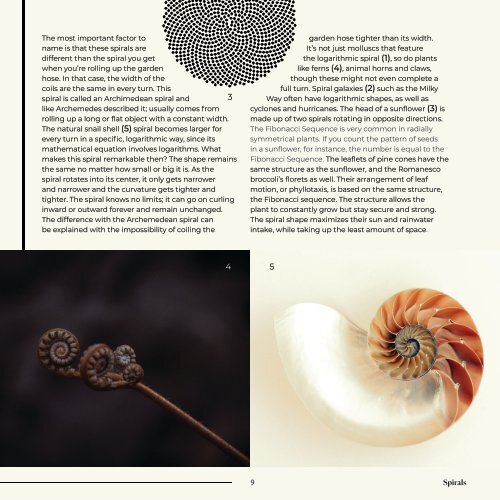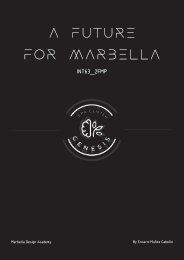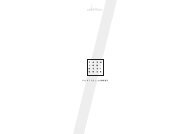Patterns in Nature, editorial design project by our 2nd-year student Ellen Andersin.
“Patterns In Nature”. A glimpse into the world of phenomenal natural patterns Editorial design project by our 2nd-year student Ellen Andersin. Marbella Design Academy - Spain – Founded 1995 - Tuition in English
“Patterns In Nature”.
A glimpse into the world of phenomenal natural patterns
Editorial design project by our 2nd-year student Ellen Andersin.
Marbella Design Academy - Spain – Founded 1995 - Tuition in English
You also want an ePaper? Increase the reach of your titles
YUMPU automatically turns print PDFs into web optimized ePapers that Google loves.
The most important factor to<br />
name is that these spirals are<br />
different than the spiral you get<br />
when you’re roll<strong>in</strong>g up the garden<br />
hose. In that case, the width of the<br />
coils are the same <strong>in</strong> every turn. This<br />
spiral is called an Archimedean spiral and 3<br />
like Archemedes described it; usually comes from<br />
roll<strong>in</strong>g up a long or flat object with a constant width.<br />
The natural snail shell (5) spiral becomes larger for<br />
every turn <strong>in</strong> a specific, logarithmic way, s<strong>in</strong>ce its<br />
mathematical equation <strong>in</strong>volves logarithms. What<br />
makes this spiral remarkable then? The shape rema<strong>in</strong>s<br />
the same no matter how small or big it is. As the<br />
spiral rotates <strong>in</strong>to its center, it only gets narrower<br />
and narrower and the curvature gets tighter and<br />
tighter. The spiral knows no limits; it can go on curl<strong>in</strong>g<br />
<strong>in</strong>ward or outward forever and rema<strong>in</strong> unchanged.<br />
The difference with the Archemedean spiral can<br />
be expla<strong>in</strong>ed with the impossibility of coil<strong>in</strong>g the<br />
garden hose tighter than its width.<br />
It’s not just molluscs that feature<br />
the logarithmic spiral (1), so do plants<br />
like ferns (4), animal horns and claws,<br />
though these might not even complete a<br />
full turn. Spiral galaxies (2) such as the Milky<br />
Way often have logarithmic shapes, as well as<br />
cyclones and hurricanes. The head of a sunflower (3) is<br />
made up of two spirals rotat<strong>in</strong>g <strong>in</strong> opposite directions.<br />
The Fibonacci Sequence is very common <strong>in</strong> radially<br />
symmetrical plants. If you count the pattern of seeds<br />
<strong>in</strong> a sunflower, for <strong>in</strong>stance, the number is equal to the<br />
Fibonacci Sequence. The leaflets of p<strong>in</strong>e cones have the<br />
same structure as the sunflower, and the Romanesco<br />
broccoli’s florets as well. Their arrangement of leaf<br />
motion, or phyllotaxis, is based on the same structure,<br />
the Fibonacci sequence. The structure allows the<br />
plant to constantly grow but stay secure and strong.<br />
The spiral shape maximizes their sun and ra<strong>in</strong>water<br />
<strong>in</strong>take, while tak<strong>in</strong>g up the least amount of space.<br />
4 5<br />
9 Spirals

















